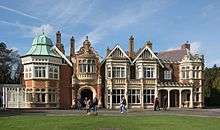Jean Valentine (bombe operator)


Jean Millar Valentine (born 1924, Perth, Scotland) was an operator of the bombe decryption device in Hut 11 at Bletchley Park in England, designed by Alan Turing and others during World War II.[1] She was a member of the "Wrens" (Women's Royal Naval Service, WRNS).[2] She was one of a number of women who worked at Bletchley Park.[3] During this time, she lived in Steeple Claydon in Buckinghamshire. She started working on 15 shillings (75 pence) a week. Along with her co-workers, she remained quiet about her war work until the mid-1970s.
More recently, Jean Valentine has been involved with the reconstruction of the bombe at Bletchley Park Museum,[4] completed in 2006.[5] In 2006, she said: "Unless people come pouring through the doors, a vital piece of history is lost. The more we can educate them, the better."[6] She demonstrates the reconstructed bombe at the Bletchley Park Museum[7][8] and also leads tours there.[9][10][11] She participated in a major reunion at Bletchley Park in 2009.[12][13]
On 24 June 2012, Jean Valentine spoke on her wartime experiences at Bletchley Park and elsewhere as part of a Turing's Worlds event to celebrate the centenary of the birth of Alan Turing, organized by the Department for Continuing Education's Rewley House at Oxford University in cooperation with the British Society for the History of Mathematics (BSHM).[14][15]
Valentine mentions during an interview conducted by Joe Miller for the BBC, how moving down to London was a new experience for her, as she had never been out of Scotland up to that point. Valentine worked for eight hours during the day at Bletchley Park and mentioned how no one would ever talk about what they have done or would be doing when outside of Bletchley Park. Valentine worked in Hut 11 as has been previously mentioned, recalling how there would be “five machines within the hut, ten girls and one petty officer that would be in charge of the telephone”. [16][17]
See also
References
- ↑ ComputerHeritage. "Operating the Bombe: Jean Valentine's story". YouTube. Retrieved 28 July 2014.
- ↑ Lewis, Katy (3 June 2009). "Breaking the codes: Former Bletchley Park Wren, Jean Valentine, reveals exactly what went on at the World War II codebreaking centre". Beds, Herts & Bucks. BBC. Retrieved 28 July 2014.
- ↑ The Women of Bletchley Park, Finding Ada, 26 July 2009.
- ↑ What to see at Bletchley Park: Bombe Rebuild Project, Bletchley Park, UK.
- ↑ Fenton, Ben (7 September 2006). "Bletchley hums again to the Turing Bombe". The Telegraph.
- ↑ Addley, Esther (7 September 2006). "Back in action at Bletchley Park, the black box that broke the Enigma code". The Guardian.
- ↑ Jean Valentine explains the bombe on YouTube.
- ↑ Jean Valentine explains the bombe, CastTV.
- ↑ BCSWomen trip to Bletchley Park, BCSWomen, UK, 8 May 2008.
- ↑ "The geese that laid the golden egg — but never cackled — Winston Churchill". Skirts and Ladders. Archive.org. 26 July 2009. Archived from the original on 14 March 2016.
- ↑ Feature: Decoding Bletchley Park's history, Gizmag Emerging Technology Magazine.
- ↑ The Wider View: Nazi codebreaker which shortened the Second World War by two years. The Mail on Sunday, 30 March 2009.
- ↑ 'Geese' cackle over Enigma: British code breakers reunite to celebrate secret work that helped Allies defeat Nazis, The Star, Toronto, Canada, 25 March 2009.
- ↑ "Driving Miss Valentine". Diaphania.blogspirit.com. Blogspot. 6 July 2012. Retrieved 3 September 2012.
- ↑ Valentine, Jean (2017). "A Wren's eye view". In Copeland, Jack; et al. The Turing Guide. Oxford University Press. pp. 125–127. ISBN 978-0-19-874783-3.
- ↑ Fessenden, Marissa. "Women Were Key to WWII Code-Breaking at Bletchley Park". Retrieved 8 March 2018.
- ↑ computingheritage (14 March 2013). "Operating the Bombe: Jean Valentine's story". Retrieved 8 March 2018 – via YouTube.